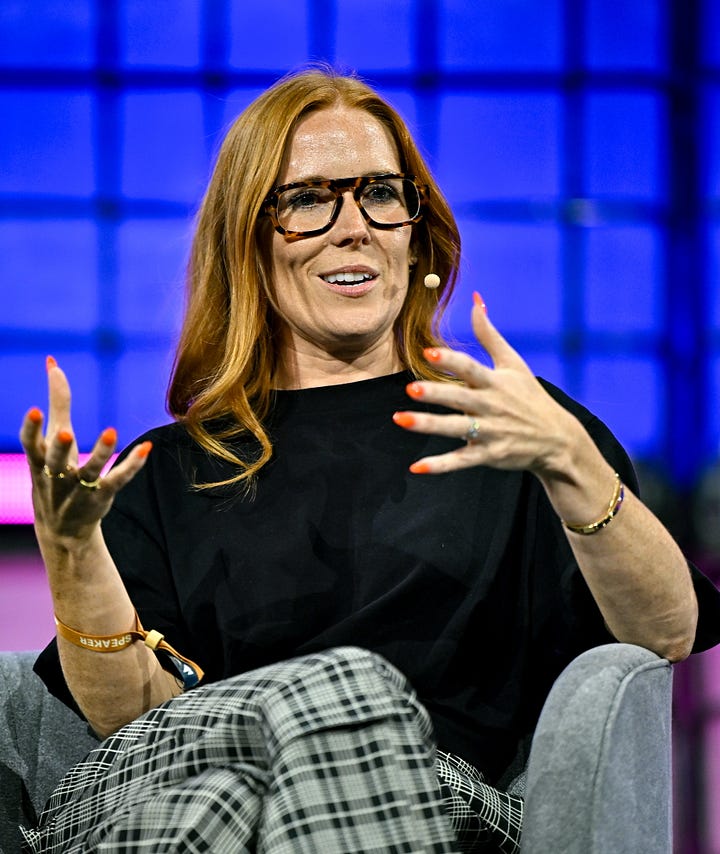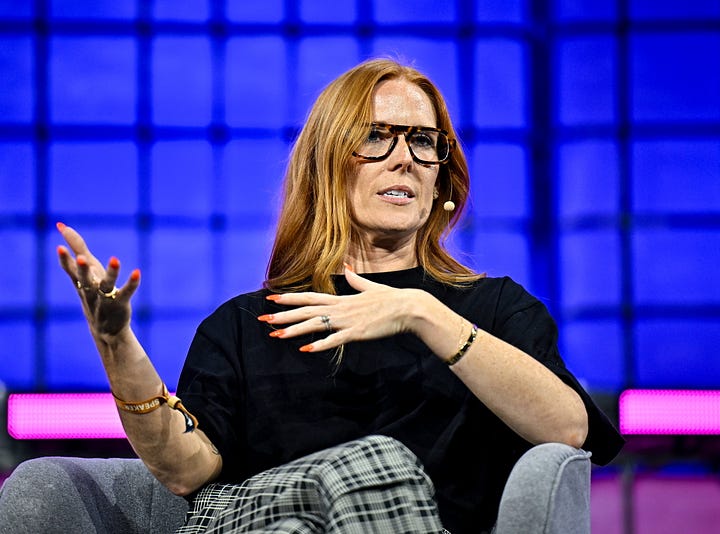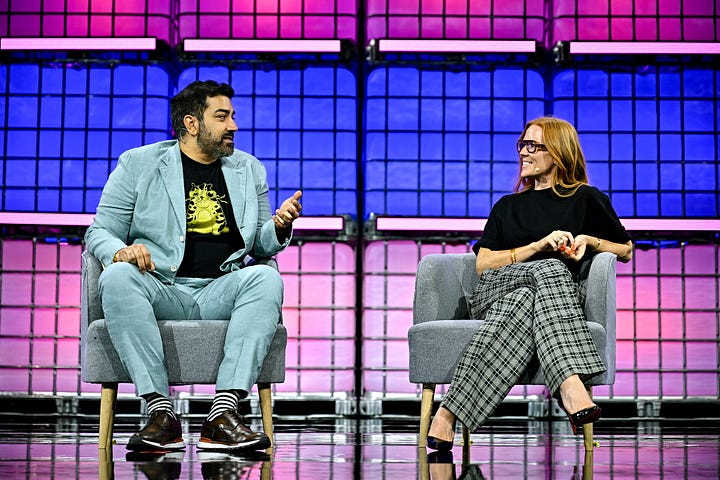The Untapped Billion
The future of fandoms - from viewership to world-building
Thank you for being here. You are receiving this email because you subscribed to Idée Fixe, the newsletter for curious minds. I’m Toni Cowan-Brown, a tech and F1 commentator. I’ve spent the past five years on the floor of way too many F1, FE, and WEC team garages, learning about the business, politics, and tech of motorsports. I hope you’ll stick around.
⏳ Reading time: 8min
The Future of Fandoms - From Viewership to World-Building
I attended a panel at Web Summit on Centre Stage called The Future of Fandoms, and it left me thinking: we’re not witnessing an evolution in sports media - we’re living through a complete rehaul. A total redesign of what it means to be a fan, how fans show up, and how leagues/series, teams, and media companies need to respond.
So this is what this week’s newsletter will cover. This is also the perfect opportunity to re-introduce why I started Sunday Fangirls four years ago and highlight the economic power and relevancy of young female (sports) fans.
Let’s start with the word itself. Fandom literally means “the domain of fans.”
It stems from fanaticus (once used in religious contexts) and the suffix -dom (like kingdom or freedom) which, to me, highlights the idea that it is so much more than the sum of these individuals.
What fandom evokes today is something far more expansive: It’s community, identity, belonging, creativity, and above all, power.
Fandoms don’t just follow - they shape narratives, influence decisions, and commercialise culture. Just ask DC Studios about the Snyder Cut. Or look at how fan-led memes and edits fueled Oscar Piastri’s rise in F1. Or how NBA players like are minted into cultural icons not just by ESPN, but by TikTok and YouTube shorts. So, what does the modern sports fan want? Is it safe to say that the next generation of sports fans is consuming and following sports more so than watching sports?
Sunday Fangirls - the Untapped Billion
For decades, female fans - especially young women - have been unfairly dismissed as hysterical, shallow, or lust-driven in spaces like music and sports, including Formula 1. While male fans are often perceived as insightful and serious, their female counterparts are routinely belittled, reduced to stereotypes like crazed groupies. This double standard reflects deeper societal sexism and rigid gender norms that frame women’s passion as irrational, while men’s is seen as intellectual.
But the truth is, these so-called “fangirls” are some of the sport’s most powerful and engaged consumers. They organise, build communities, generate word-of-mouth, and drive relevance - online and off. Their knowledge may differ in form, but it’s no less valid or valuable. Beyond their economic impact, they’re pushing the culture forward, forcing long-overdue conversations about inclusivity, justice, and representation. Far from being on the sidelines, F1’s fangirls are shaping the future, and the teams that recognise this will come out ahead. This is why I created Sunday Fangirls all those years ago and why I’ve urged brands, teams, athletes and leagues to pay very close attention to this demographic, and take them seriously.
Enter Gen Alpha: The Fan as Co-Creator
If Millennials were digital natives, and Gen Z are mobile-first, Gen Alpha is co-creation-native. They’re growing up in ecosystems like Roblox, Fortnite, and TikTok - platforms built around personalisation and interactivity.
They don’t just want to watch a sport. They want to: influence it, remix it and be part of the narrative. They trust streamers more than commentators. They prefer authenticity over polish. They want both snackable chaos and sticky storytelling.
YouTube's 2024 Culture & Trends Report highlights the emergence of the "professional fan," a term describing individuals who not only engage deeply with their fandoms but also monetise their passion through content creation. The report reveals that 8% of Gen Z identify as professional fans, earning revenue by producing fan-centric content such as reaction videos, explainers, and fan art. This shift signifies a transformation in fandom, where fans evolve from passive consumers to active contributors and creators within their communities.
The study also indicates that 85% of online users aged 14–44 consider themselves fans of someone or something. This engagement often leads to content creation, further blurring the lines between fans and creators. Brands are recognising this trend, with 74% of Gen Z fans appreciating when brands engage with their fandoms.
The NBA has been especially adaptive here, encouraging players to build their brands on social, licensing footage to creators, and leaning into moments that extend far beyond the game itself. From tunnel fits to mic’d up content to fandoms built around WNBA rookies before they ever step on court - the NBA is building a multi-platform fandom engine.
This is one reason why we’ve seen an explosion of sports creators, and what YouTube refers to as the ‘professional fan’. Investing in creators is a smart financial move (just like investing in women, because apparently that still needs repeating). There is an actual dollar amount you can put next to creators - brands got $2.40 back in sales for every $1 spent on creator content in both 2021 and 2022, according to Whalar (a creator talent management company). This return on investment highlights the substantial influence creators have on consumer purchasing decisions, often surpassing that of traditional media channels, such as TV and online video. Despite accounting for only 0.7% of overall media investment, creator content was responsible for 2.6% of total sales impact, highlighting its efficiency and effectiveness in driving sales.
This data emphasises the growing importance of the creator economy in modern marketing strategies. Consumers tend to trust recommendations from creators they follow, making creator-led content a powerful tool for brands. As the advertising landscape continues to evolve, integrating creators into marketing campaigns can offer brands a competitive edge, fostering authentic connections with their audiences and driving measurable results.
The Age of Portable Fandoms
We’re now in a world where fandom is also portable, not tethered to a local team, stadium, or time zone. That shift has massive implications:
Global Reach = Global Revenue: Portable fans unlock value across media rights, merchandise, and sponsorships.
Future-Proofing: Young fans are drawn to moments, memes, and personalities, not just local teams.
Creator-Led Growth: Leagues don’t grow solely through marketing departments anymore. They grow through creators, editors, superfans, and professional fan ecosystems.
Smarter Sponsorships: Global fandom allows brands to activate more meaningfully across borders. This is why OKX can justify sponsoring the McLaren F1 team or why NBA’s partnerships in the Middle East are gaining traction.
Formula 1 is arguably one of the best case studies in the business of fandom portability. From Drive to Survive to the F1 Arcade, LEGO, Disney and Hot Wheels collabs, the upcoming Brad Pitt movie and the F1 playlist, and the immersive F1TV product, the F1 museum and arcades… F1 has gone full tilt into world-building. And it’s working. However, the one throughline here is the commercialisation of fans and their fandoms. I don’t believe every aspect of fandom need to be commercialised.
But here’s the catch: the sport still hasn’t fully embraced user-generated content. While teams and even the FIA are starting to collaborate with creators, the sport remains wary of fan-made videos and edits. That’s a miss. Because UGC isn’t just free marketing - it’s cultural currency. The likes of Formula 1 would do well to get on board, especially when Wimbledon is beating them to the punch.
One Big Thing for Legacy Media
It’s clear that sports consumption habits have evolved significantly in recent years, driven by technological advancements and changing viewer preferences. Traditional full-length broadcasts are increasingly supplemented or replaced by short-form content, highlights, and real-time updates accessible via social media platforms like Instagram, TikTok, and YouTube. Younger audiences, particularly Gen Z, favour these bite-sized, easily digestible formats, often engaging with content through mobile devices and streaming services.
The integration of social media into sports consumption has also transformed the fan experience. Fans now follow athletes and teams on social platforms, engaging with behind-the-scenes content, live interactions, and community discussions. In response to these changes, sports organisations and broadcasters are adapting their strategies to meet the evolving demands of audiences. This includes investing in digital platforms, creating short-form content tailored for social media, and exploring new formats to enhance engagement, which offer faster-paced, condensed matches or highlights streamed on platforms like YouTube and Twitch.
The biggest mistake legacy media companies can make right now?
Trying to get Gen Alpha to watch. The real question is: “How do we build worlds where Gen Alpha wants to play?”
That means embracing creator partnerships, decentralised storytelling, interactive platforms (think TikTok, Substack, Beehiiv, Threads), alternate broadcast formats and fan-led remix culture. And maybe, just maybe, being okay with a little less control. The old playbooks are gone. Fandom isn’t a viewership metric - it’s a world-building opportunity. And the leagues/series, media companies, and brands who win the next decade of sports will be the ones who build with fans, not just broadcast to them.




🔗 The Future of Fandoms (my panel) | Web Summit, Vancouver 2025
🔗 Netflix Puts F1 Academy in the Spotlight in New Docuseries | Tech Talk by Boardroom
At first glance, the high-octane world of Formula 1 might seem like a boys’ club. But just below the surface, a growing revolution is unfolding, and its name is F1 Academy. Launched in 2023, this all-women, single-seater racing series has quickly become one of the most strategic moves in the motorsport industry to create lasting gender equity on the track. Read here.





